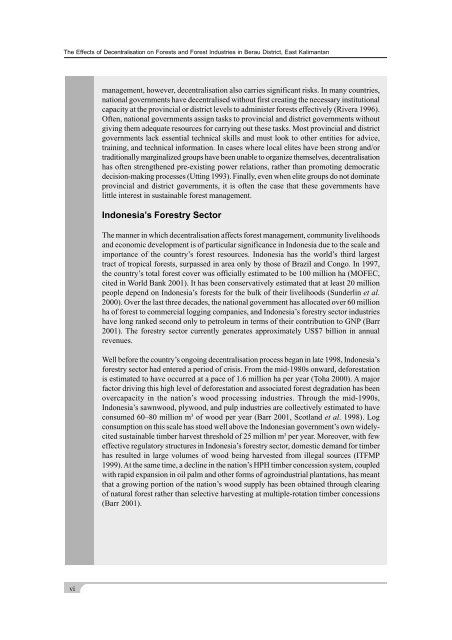The Effects of Decentralisation on Forests and Forest Industries in
The Effects of Decentralisation on Forests and Forest Industries in
The Effects of Decentralisation on Forests and Forest Industries in
Create successful ePaper yourself
Turn your PDF publications into a flip-book with our unique Google optimized e-Paper software.
<str<strong>on</strong>g>The</str<strong>on</strong>g> <str<strong>on</strong>g>Effects</str<strong>on</strong>g> <str<strong>on</strong>g>of</str<strong>on</strong>g> <str<strong>on</strong>g>Decentralisati<strong>on</strong></str<strong>on</strong>g> <strong>on</strong> <strong><strong>Forest</strong>s</strong> <strong>and</strong> <strong>Forest</strong> <strong>Industries</strong> <strong>in</strong> Berau District, East Kalimantan<br />
management, however, decentralisati<strong>on</strong> also carries significant risks. In many countries,<br />
nati<strong>on</strong>al governments have decentralised without first creat<strong>in</strong>g the necessary <strong>in</strong>stituti<strong>on</strong>al<br />
capacity at the prov<strong>in</strong>cial or district levels to adm<strong>in</strong>ister forests effectively (Rivera 1996).<br />
Often, nati<strong>on</strong>al governments assign tasks to prov<strong>in</strong>cial <strong>and</strong> district governments without<br />
giv<strong>in</strong>g them adequate resources for carry<strong>in</strong>g out these tasks. Most prov<strong>in</strong>cial <strong>and</strong> district<br />
governments lack essential technical skills <strong>and</strong> must look to other entities for advice,<br />
tra<strong>in</strong><strong>in</strong>g, <strong>and</strong> technical <strong>in</strong>formati<strong>on</strong>. In cases where local elites have been str<strong>on</strong>g <strong>and</strong>/or<br />
traditi<strong>on</strong>ally marg<strong>in</strong>alized groups have been unable to organize themselves, decentralisati<strong>on</strong><br />
has <str<strong>on</strong>g>of</str<strong>on</strong>g>ten strengthened pre-exist<strong>in</strong>g power relati<strong>on</strong>s, rather than promot<strong>in</strong>g democratic<br />
decisi<strong>on</strong>-mak<strong>in</strong>g processes (Utt<strong>in</strong>g 1993). F<strong>in</strong>ally, even when elite groups do not dom<strong>in</strong>ate<br />
prov<strong>in</strong>cial <strong>and</strong> district governments, it is <str<strong>on</strong>g>of</str<strong>on</strong>g>ten the case that these governments have<br />
little <strong>in</strong>terest <strong>in</strong> susta<strong>in</strong>able forest management.<br />
Ind<strong>on</strong>esia’s <strong>Forest</strong>ry Sector<br />
<str<strong>on</strong>g>The</str<strong>on</strong>g> manner <strong>in</strong> which decentralisati<strong>on</strong> affects forest management, community livelihoods<br />
<strong>and</strong> ec<strong>on</strong>omic development is <str<strong>on</strong>g>of</str<strong>on</strong>g> particular significance <strong>in</strong> Ind<strong>on</strong>esia due to the scale <strong>and</strong><br />
importance <str<strong>on</strong>g>of</str<strong>on</strong>g> the country’s forest resources. Ind<strong>on</strong>esia has the world’s third largest<br />
tract <str<strong>on</strong>g>of</str<strong>on</strong>g> tropical forests, surpassed <strong>in</strong> area <strong>on</strong>ly by those <str<strong>on</strong>g>of</str<strong>on</strong>g> Brazil <strong>and</strong> C<strong>on</strong>go. In 1997,<br />
the country’s total forest cover was <str<strong>on</strong>g>of</str<strong>on</strong>g>ficially estimated to be 100 milli<strong>on</strong> ha (MOFEC,<br />
cited <strong>in</strong> World Bank 2001). It has been c<strong>on</strong>servatively estimated that at least 20 milli<strong>on</strong><br />
people depend <strong>on</strong> Ind<strong>on</strong>esia’s forests for the bulk <str<strong>on</strong>g>of</str<strong>on</strong>g> their livelihoods (Sunderl<strong>in</strong> et al.<br />
2000). Over the last three decades, the nati<strong>on</strong>al government has allocated over 60 milli<strong>on</strong><br />
ha <str<strong>on</strong>g>of</str<strong>on</strong>g> forest to commercial logg<strong>in</strong>g companies, <strong>and</strong> Ind<strong>on</strong>esia’s forestry sector <strong>in</strong>dustries<br />
have l<strong>on</strong>g ranked sec<strong>on</strong>d <strong>on</strong>ly to petroleum <strong>in</strong> terms <str<strong>on</strong>g>of</str<strong>on</strong>g> their c<strong>on</strong>tributi<strong>on</strong> to GNP (Barr<br />
2001). <str<strong>on</strong>g>The</str<strong>on</strong>g> forestry sector currently generates approximately US$7 billi<strong>on</strong> <strong>in</strong> annual<br />
revenues.<br />
Well before the country’s <strong>on</strong>go<strong>in</strong>g decentralisati<strong>on</strong> process began <strong>in</strong> late 1998, Ind<strong>on</strong>esia’s<br />
forestry sector had entered a period <str<strong>on</strong>g>of</str<strong>on</strong>g> crisis. From the mid-1980s <strong>on</strong>ward, deforestati<strong>on</strong><br />
is estimated to have occurred at a pace <str<strong>on</strong>g>of</str<strong>on</strong>g> 1.6 milli<strong>on</strong> ha per year (Toha 2000). A major<br />
factor driv<strong>in</strong>g this high level <str<strong>on</strong>g>of</str<strong>on</strong>g> deforestati<strong>on</strong> <strong>and</strong> associated forest degradati<strong>on</strong> has been<br />
overcapacity <strong>in</strong> the nati<strong>on</strong>’s wood process<strong>in</strong>g <strong>in</strong>dustries. Through the mid-1990s,<br />
Ind<strong>on</strong>esia’s sawnwood, plywood, <strong>and</strong> pulp <strong>in</strong>dustries are collectively estimated to have<br />
c<strong>on</strong>sumed 60–80 milli<strong>on</strong> m 3 <str<strong>on</strong>g>of</str<strong>on</strong>g> wood per year (Barr 2001, Scotl<strong>and</strong> et al. 1998). Log<br />
c<strong>on</strong>sumpti<strong>on</strong> <strong>on</strong> this scale has stood well above the Ind<strong>on</strong>esian government’s own widelycited<br />
susta<strong>in</strong>able timber harvest threshold <str<strong>on</strong>g>of</str<strong>on</strong>g> 25 milli<strong>on</strong> m 3 per year. Moreover, with few<br />
effective regulatory structures <strong>in</strong> Ind<strong>on</strong>esia’s forestry sector, domestic dem<strong>and</strong> for timber<br />
has resulted <strong>in</strong> large volumes <str<strong>on</strong>g>of</str<strong>on</strong>g> wood be<strong>in</strong>g harvested from illegal sources (ITFMP<br />
1999). At the same time, a decl<strong>in</strong>e <strong>in</strong> the nati<strong>on</strong>’s HPH timber c<strong>on</strong>cessi<strong>on</strong> system, coupled<br />
with rapid expansi<strong>on</strong> <strong>in</strong> oil palm <strong>and</strong> other forms <str<strong>on</strong>g>of</str<strong>on</strong>g> agro<strong>in</strong>dustrial plantati<strong>on</strong>s, has meant<br />
that a grow<strong>in</strong>g porti<strong>on</strong> <str<strong>on</strong>g>of</str<strong>on</strong>g> the nati<strong>on</strong>’s wood supply has been obta<strong>in</strong>ed through clear<strong>in</strong>g<br />
<str<strong>on</strong>g>of</str<strong>on</strong>g> natural forest rather than selective harvest<strong>in</strong>g at multiple-rotati<strong>on</strong> timber c<strong>on</strong>cessi<strong>on</strong>s<br />
(Barr 2001).<br />
vi

















